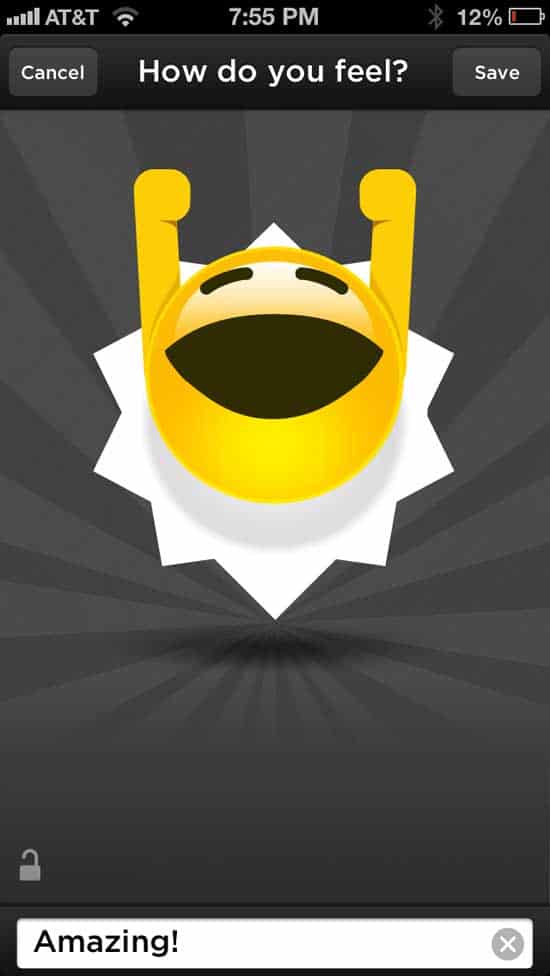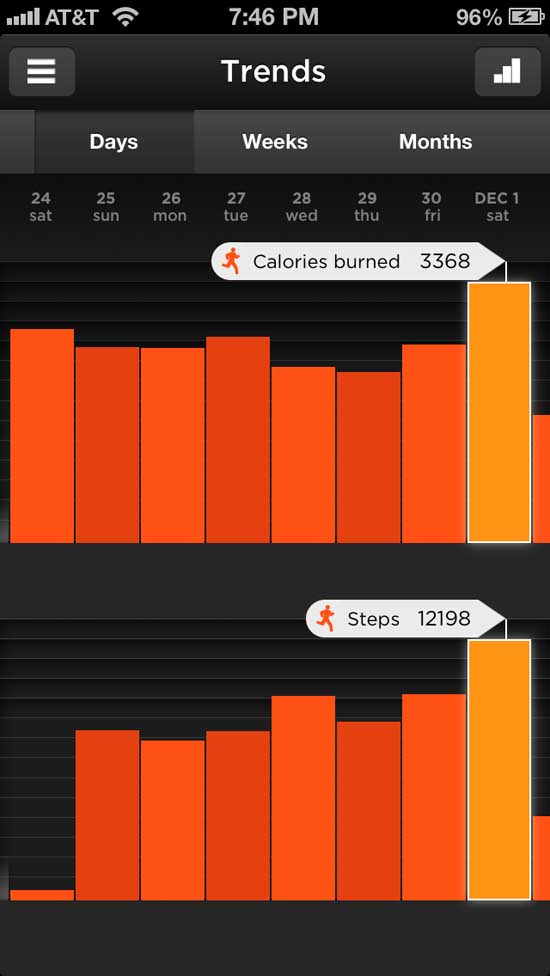Part of the reason why I wanted to start reviewing these fitness gadgets is because, as I’m still deciding what I want my personal training business to look like, I need to find the tools that are best going to help me help my clients. And, aside from that, there are people out there who genuinely want to know how I think these gadgets could (or should) fit into their daily lives… or if they’re even worth the fuss.
That being said, after spending a week with the Jawbone Up, I can definitely say that I don’t think this kind of tool is for everybody, but… if it’s for you, it’s really for you.
When you look at what the Up has to offer, you realize it’s not really about weight loss – the lack of a heart rate monitor and a more comprehensive analysis of activity levels tells you that – but so many of the regular components of the Up help you keep track of things that contribute heavily toward successful weight management.
Take, for instance, the settings that allow for you to keep track of your mood. Each time you log into your Up’s phone app, you get to input your mood. Do you feel “bummed out?” “Drained?” How about “Excited?”
Suppose you’re diligent about updating every aspect of your life into your Up, and let’s say that today, you’re having a bad day. Before you head to bed, you sync your Up and realize that what’d really contributed to your bad day was the fact that you only got four hours of sleep, ate very little today, and wound up getting in 19,000 steps, anyway. You clearly had a busy day, but it’s obvious that you didn’t get in enough rest to prepare you for the day, nor did you get in enough energy to fuel the activity.
Perhaps, over the course of a week, you realize that you’ve had good days that were fantastic, and bad days that made you feel like curling up in a ball, fetal position style, and stay there for a few days. Well, you can track that by looking at the Jawbone Up app’s “Trends” tab, which allows you to compare any two sets of data to see how they relate:
Because of the way the data is set up, with everything being tracked by calendar day (as input by you), you can compare just about anything by day:
The Up, if you’re committed to the input of data (and many of us are and can be), is an invaluable means of understanding your life and how it affects your health. If I were working with a person who was completely new to the idea of living a more fit, healthier life, I’d use this.. specifically for this purpose. When I ask you, “how did you feel about today?” and you respond, “not good,” what’s the first thing I’m going to tell you? “Go into your Up app, and look at your trends.” Did you only eat two bananas today? Did you not get enough rest?
To me, the “Trends” is what makes the app. This is the part that can really serve as the life changer. Did you gain weight? Look at your trends, and compare this week to last week. Have your steps gone down? Have you been skipping workouts? Let’s compare your “calories burned” each day to your “workouts logged” each day. (Though I’ve complained about the inaccuracy of the “calories burned” metric, the app still tries to give a rough estimate of your caloric burn…which is still better than the goose egg that’d be there if you skipped your workout entirely.) Not going number 2 enough? Let’s compare that “fiber consumed” with the “calories consumed.”
However… because the wristband fails to do valuable things like monitor heart rate during exercise, or give accurate caloric burn, or even track important things like body fat percentage… the app fails to meet basic needs of someone serious about fitness. Someone like me, who really tracks her heart rate zones when she’s doing cardio intervals or uses heart rate to gauge just how challenging a lift is, I need that immediate information, and the Up isn’t built for that. In reality, it’s clear that it wasn’t meant for that, either.
All in all, I’d use it… I’d just have to pair it with my trusty rusty heart rate monitor. It’s my baby, anyway. Me and her… we never part.
You can review earlier posts about the Jawbone Up here:
- First Introductions To The Jawbone Up
- What Does A Day’s Worth Of Data Look Like?
- What’s Wrong With The Jawbone Up?
You can also purchase the Up – for almost $40 cheaper than what I purchased it for – at Amazon.




8 comments
I just started exercising so far I could only do water aerobic, swimming, yoga, exercise ball and pilates. My upper body strength is really weak and I am in physical therapy for back issues. previously I started to advanced in exercise and injured myself. I am currently building up to take it to another level again. Mostly now I am curious to see how much calories I burn . I recently bought a food scale to try to track calories. I am new to fitness but my goal is to be heathier.
Thank you for sharing your experience with the Jawbone Up. I have been very curious about all of the attention it has been getting and I wasn’t sure if it was something that I would want to purchase, but the ability to track my information on a day to day basis and compare it against other days is a very nice feature. Perhaps I should download the app and take a look at it to see if it’s something I should buy. (actually I just downloaded it and will be taking a look at it’s features). Thanks again!
Hi Erika,
I just read your post on the Up.
What I really noticed was your intense love for your heart rate monitor. Me too! I feel the same way.
If I can share for a moment, at 6 feet tall I lost around 35 lbs from 220 to 185. The monitor played such an important role in my weight loss (and improved fitness) that I’m surprised this has never been recommended to me before. I’m 42 years old, so I’ve been around the block a few times – and it’s a big block – and I don’t recall a heart rate monitor as a must have item for health and fitness. Well it is, it definitely is! I feel it’s something that should have been introduced to us in high school or even earlier as an essential item. The fact that I survived this long without clearly understanding my caloric relationship between food and exercise is utterly staggering. At least now I can put it into perspective.
Anyway, I now push friends or colleagues to get a HRM if they are serious about improving their fitness and obtaining measurable weight loss. I should also add that I didn’t lose any weight for about 4 months once I started using it, but then after I crunched some of the data, I realized I needed to increase my output by about 15 minutes (200 – 250 calories) to make it a 45 minute workout instead of 30 minutes, and then the weight just melted off – week after week, 2 lbs. Of course diet played an important role and for me, once I started feeling better and looking better my brain wanted to eat better. I’m not sure if that’s normal for everyone, but I suspect it’s a bonus side effect of exercise.
That’s it. Erika, thanks for your blog.
Chris
Oh, that’s ANOTHER post. I LIVE for my HRM. Easily one of – if not THE – best purchase I’ve made all year.
What HRM do you use?
I currently have a FitBit One and, while I won’t say it’s useless, I’m not horribly fond of it. Unless you adjust the location of the clip for the specific activity you’re doing (not something recommended by FitBit but a trick I found on a user site) it does not track calorie burn well. Any exercise that doesn’t involve moving the upper body isn’t counted as active so all the resistance training, cycling, and skating I do is just as noted as normal activity. Much like my hair, it shouldn’t go into a pool but, also, much like my hair, it ends up there rather often and hasn’t suffered any ill effects.
It’s a nice gadget for tracking steps and walking upstairs but I live in a second floor apartment in the ghetto and my gym doesn’t have a stair climber so I’m sure you can imagine exactly how many flights of stairs I go up in my average day.
The best thing about it is it challenges you to take 10000 steps a day. Better than nothing, wish I’d read a few more comparative reviews before I got it. I’ve been told it’s stellar if put with a heart rate monitor but I’m not sure if I can get the 10$ watch from Target or if I should get something more elaborate or if there’s anything less noticeable because I hate wearing watching.
This one.
I use the app fitocracy…mostly for additional motivation. It is kind of like a social networking app but geared towards fitness. You can give ‘props’ to people and other members who I am friends with can call me out if I don’t log any exercise for a little bit. I am finding it keeps me honest.
My favourite thing for fitness I have is my ballet shoes 🙂 and my navy leotard and dance skirt. I may only be an adult beginner but I sure feel like a dancer sometimes!
Hey, I’m a white guy so I don’t know if I’m the right demographic for your blog, but I really appreciated this post on the Jawbone Up. I like the suggestions you provided on data tracking. I didn’t really know how to make sense of comparing data, but you made it clear.
Good luck to you.
Comments are closed.